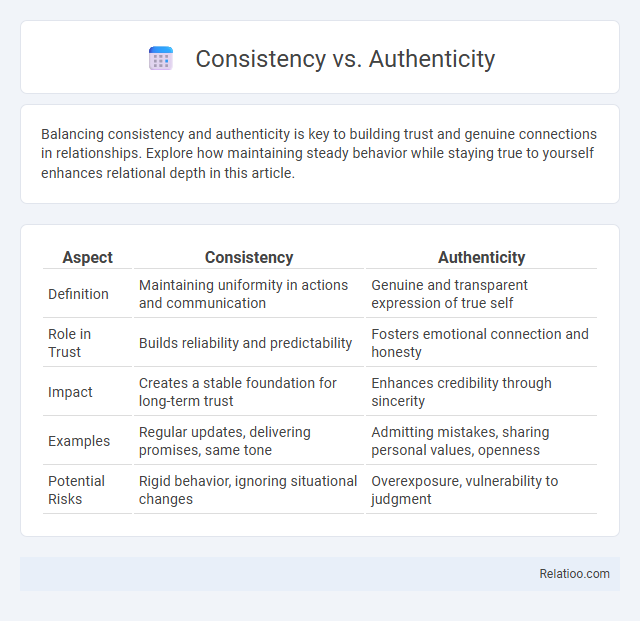Balancing consistency and authenticity is key to building trust and genuine connections in relationships. Explore how maintaining steady behavior while staying true to yourself enhances relational depth in this article.
Table of Comparison
| Aspect | Consistency | Authenticity |
|---|---|---|
| Definition | Maintaining uniformity in actions and communication | Genuine and transparent expression of true self |
| Role in Trust | Builds reliability and predictability | Fosters emotional connection and honesty |
| Impact | Creates a stable foundation for long-term trust | Enhances credibility through sincerity |
| Examples | Regular updates, delivering promises, same tone | Admitting mistakes, sharing personal values, openness |
| Potential Risks | Rigid behavior, ignoring situational changes | Overexposure, vulnerability to judgment |
Understanding Consistency and Authenticity
Consistency involves maintaining uniformity in actions, messages, and values across time, which builds trust and reliability with audiences and stakeholders. Authenticity centers on expressing genuine, transparent, and true-to-self values and beliefs, fostering deep connections and credibility. Understanding the balance between consistency and authenticity enables brands and individuals to cultivate lasting relationships by being reliably true to their core identity.
The Importance of Consistency in Personal Branding
Consistency in personal branding ensures a clear, recognizable identity across all platforms, fostering trust and credibility with your audience. Authenticity complements consistency by reflecting genuine values and personality, making your brand relatable and memorable. Prioritizing consistency solidifies your message, helping to build long-term relationships and distinguish you in competitive markets.
Authenticity: Staying True to Yourself
Authenticity means embracing your true self and expressing your unique values and beliefs in every situation, which fosters genuine connections and personal fulfillment. While consistency ensures reliability and authenticity builds trust, prioritizing authenticity empowers you to navigate challenges with integrity and confidence. Your ability to stay true to yourself creates a foundation for meaningful relationships and sustainable growth.
The Risks of Overemphasizing Consistency
Overemphasizing consistency can lead to rigidity and stifle creativity, causing your brand or personal identity to feel inauthentic and disconnected from evolving values or audience expectations. Prioritizing consistency at the expense of authenticity risks alienating your audience by appearing insincere or overly scripted. Balancing consistency with authenticity ensures your message resonates deeply while maintaining reliability and trust.
The Power of Authentic Connections
Authenticity fosters genuine relationships by encouraging trust and emotional resonance, which fuels long-term engagement far beyond surface-level consistency. While consistency ensures reliability and establishes brand recognition, true connection emerges when authenticity aligns with consistent messaging, creating a harmonious experience that captivates audiences. Brands leveraging authentic connections outperform competitors by cultivating loyalty rooted in meaningful interactions rather than repetitive messaging alone.
Finding Balance Between Consistency and Authenticity
Finding the balance between consistency and authenticity is crucial for building trust and maintaining a genuine connection with your audience. Consistency ensures your message and branding remain reliable, while authenticity allows your true values and personality to shine through, creating deeper engagement. By aligning your actions and communication with your core beliefs, you can deliver a consistent yet authentic experience that resonates with your audience and strengthens your identity.
Real-World Examples: Consistency vs Authenticity
Nike exemplifies the power of consistency by maintaining its signature "Just Do It" slogan and athletic-focused branding across decades, fostering strong customer recognition. In contrast, Dove prioritizes authenticity through its "Real Beauty" campaign, showcasing diverse, unretouched images to build genuine emotional connections and brand trust. These real-world examples highlight how consistency reinforces brand identity, while authenticity drives deeper consumer engagement and loyalty.
Strategies to Harmonize Consistency with Authenticity
Balancing consistency with authenticity requires implementing clear communication strategies that reflect your core values while adapting to evolving audience expectations. Your brand's messages should align closely with its genuine identity yet maintain regularity in tone and delivery to build trust and recognition. Employ feedback loops and authentic storytelling to ensure consistency does not compromise the unique voice that distinguishes your brand.
Overcoming Challenges in Aligning Values and Actions
Aligning values and actions requires overcoming challenges related to consistency, authenticity, and integrity, where inconsistency can undermine trust and personal growth. Authenticity demands self-awareness and vulnerability, making it difficult to maintain genuine expressions while meeting external expectations. Building alignment involves deliberate reflection, transparent communication, and adaptive behavior to ensure values are faithfully represented through consistent, authentic actions.
Building Trust Through Balanced Presence
Building trust requires balancing consistency and authenticity by maintaining a reliable presence while expressing genuine values and personality. Your audience responds positively when your messages align across platforms, reflecting honesty without sacrificing clarity or commitment. Achieving this balance fosters long-term relationships and reinforces credibility in every interaction.

Infographic: Consistency vs Authenticity
 relatioo.com
relatioo.com